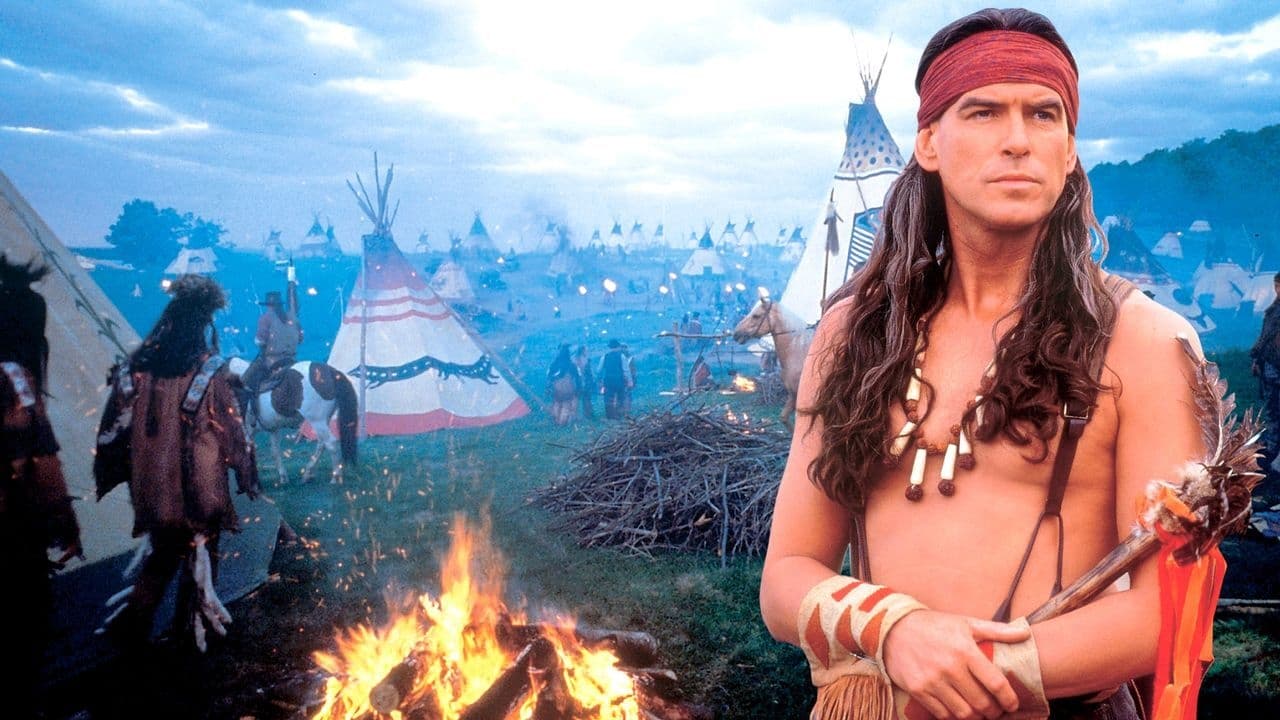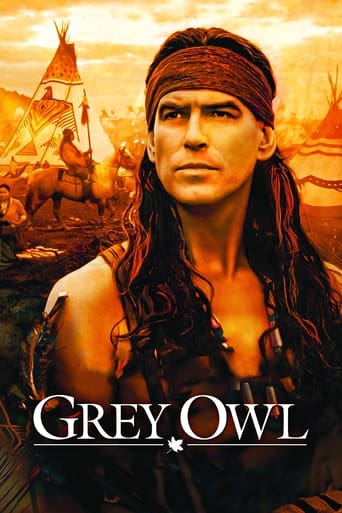

Released is 1999 and directed by Richard Attenborough, "Grey Owl" stars Pierce Brosnan as the real-life Archibald Belaney, known as Grey Owl. Claiming partial aboriginal American ancestry, Grey Owl lived as a fur trapper in Temagami, Ontario. Upon meeting the winsome civilized Mohawk, Gertrude Bernard, aka "Pony" (Annie Galipeau), he delved more seriously into writing and became a renowned conservationist in the early 1930s."Grey Owl" is the farthest thing from a conventional Western and could more aptly be described as a Wilderness Drama/Romance. People keep claiming that Belaney lived in Northern Ontario when Temagami Island and Bear Island are decidedly in Southern Ontario, about 200 miles north of Toronto. Simply being North of Toronto doesn't make it "Northern Ontario." As far as Brosnan goes, he is actually very fitting for the eponymous role because (1.) Belaney had a similar build/look and (2.) Belaney was at best half-British (the ending clears this up).Someone claimed that the truth about Belaney wasn't discovered until after his death from pneumonia in 1938, his body weakened by habitual alcoholism. No, stories about his dubious identity had been circulating for years and, as shown in the movie, the North Bay Nugget held on to the revelatory story for three years before his death out of respect for the man's conservationist work, which the newspaper promptly printed after his decease.In any case, to enjoy this film you have to be in the mode for a low-key drama "Western" with lots of romance. If not, you'll likely be bored to death. I found the first half rather dull, but the movie made up for it by Brosnan's stalwart depiction, Galipeau's unique beauty, the magnificent eastern Canada cinematography and the cute baby beavers. The second half, however, becomes more compelling, as the truth about Belaney is slowly revealed. Unfortunately, the movie fails to include two important points about Grey Owl: (1.) Belaney's known alcoholism and (2.) the fact that his wonderful relationship with Gertrude (as illustrated in the move, that is) ended roughly two years before his death.The film runs 118 minutes and was shot in Quebec (Chelsea & Wakefield) & Prince Albert National Park, Saskatchewan, as well as Hastings, East Sussex, England. The script was written by William Nicholson.GRADE: B or B- (6.5/10)
... View MoreA number of Richard Attenborough's films as director have been biographies of major historical figures- "Young Winston", "Gandhi", "Chaplin". "Grey Owl" is also a filmed biography of a historical individual, but in this case Attenborough's subject is a much more obscure character.Grey Owl was a Canadian writer of the 1920s and 1930s who promoted the ideas of environmentalism and nature conservation at a time when these causes were less fashionable than they are today. He was widely believed to be an American Indian; the story he told about himself was that he had been born in Mexico to a Scottish father and Apache mother and had emigrated to Canada where he had been adopted as a member of the Ojibway tribe. He lived in a cabin by a lake in a remote part of the Canadian wilderness, where he earned a living as a trapper. He toured Britain twice, in 1935 and 1937, to promote his books and to give lectures on conservationism, and achieved great success, even being introduced to the Royal Family. (During one of these tours Attenborough, then a teenager, saw Grey Owl at the London Palladium theatre). After his death in 1938, however, it was revealed that he had not been who he claimed to be; his real name was Archibald Belaney, and he had been born in the English seaside town of Hastings.The film departs somewhat from the facts of Grey Owl's life. In a scene set in 1934 he states that he is 41 years old; in reality, he was born in 1888 so would have been 46 in that year. (46 would have been Pierce Brosnan's age when the film was made, so I am not sure why this change was made). Numerous events are compressed into the last four years of Grey Owl's life (1934-1938). In the film it is during this period that he meets and marries Gertrude Bernard whom he called Anahareo; in reality, he met and married Gertrude as early as 1925. The film also omits the fact that they were divorced in 1936 and that Grey Owl remarried shortly before his death.The revelation of Grey Owl's true identity adversely affected his posthumous reputation, and he was dismissed as a "fraud". His supposed deceit was even used to discredit the causes which he had championed. Richard Attenborough, however, takes a more sympathetic view of his achievements. One of the themes explored by the film is the question of ethnic identity. Although the erstwhile Archibald Belaney was not a Canadian Indian by birth, there is no doubt that he had a deep knowledge of Ojibway culture and lore and that he spoke their language fluently. He was accepted by the Ojibway as a member of their tribe. It therefore seems unfair to describe his claim to a Native North American identity as being a fraudulent one, merely because it was an identity he had chosen rather than one he had been born into.According to the film, Grey Owl's wife Gertrude was herself of Indian descent, but came from a family which had been assimilated into white Canadian culture. Her marriage can therefore be seen as her reclamation of her family's original cultural heritage. She was clearly influenced by her husband, but she also had an influence on him, persuading him to give up his work as a fur trapper as she had moral objections to killing animals for their fur.One criticism made of the film is that Pierce Brosnan is "miscast" as the hero, a criticism which seems to be rooted in the preconception that Brosnan can only play action heroes in the James Bond mould. It seems to me, however, that Brosnan may deliberately have taken this role in order to avoid being typecast, the taciturn backwoodsman Grey Owl being about as far from the suave, sophisticated agent Bond as one can get. The original Bond, Sean Connery, also seems to have deliberately opted for contrasting roles when he appeared in films like "The Hill" or "The Molly Maguires". Brosnan is in fact very good in this role, although I would agree with those who found Annie Galipeau weak as Gertrude.Another frequently-voiced criticism with which I would not agree is that the film is "boring". Certainly, it is not an action film like the Bonds, nor is it a great epic biopic like "Gandhi", and it may indeed seem boring to those who were expecting it to be either the one or the other. It is however, likely to please anyone with an interest in the early days of the conservationist movement or the philosophical implications of national and ethnic identity. The scenes of the Canadian forests are also beautifully photographed. Richard Attenborough has done us a service by helping to revive interest in this half-forgotten but fascinating figure. 7/10
... View MoreWe really enjoyed Grey Owl: a simple tale well told in classic Attenborough fashion: a little over-romanticized, with archetypes, humor, and a stress of dignity and values.Beautifully shot and told at a nice pace this is the true story of Archie, an Englishman who turned native Indian, and went to live and trap in Canada.Solid performances from all makes this film with a message easy viewing.Two of the stars of the film are without a doubt the cutest we have ever seen - and the message is a good one with its ecoleanings. It must have been great to meet or read Grey Owl in the 1930s, a unique character and this is a fitting film tribute.
... View MoreJames Bond in the wilderness? Well, that's the way it looks: Pierce Brosnan is after all best known as Bond in "Tommorrow Never Dies" (1997) and "Golden Eye" (1995) - both shot prior to this release. Frankly, the film's two leads are both badly miscast, with Brosnan turning in the marginally more convincing performance, and with Annie Galipeau (as Pony, Grey Owl's love interest) having to battle with carelessly-written dialogue.The two aunts, on the other hand are perfect. But the film is not about aunts. It is about the wilds of the Canadian wilderness. And while the photography may be pretty, there is no grit to the harsh reality of living in the wilds. Annie Galipeau, as Pony, just fails to be convincing, unfortunately, because I really wanted to believe in her. She was a relatively inexperienced twenty-year-old on this film, and it could have worked, but Richard Attenborough was maybe just not tough enough on her. He makes her look vulnerable, which of course she is.. but in the wrong sort of way.But one thing for sure, she appears picture-perfect throughout. But mascara and eyebrow thickener in the wilderness? It just doesn't fit, especially as she only ever seems to walk forest trials with Bond (sorry, Grey Owl), and use photo-ops for kissing close-ups.I've lived with forest people in the Pacific North West, and they simply don't look this pretty and stay so sweet while fighting for survival. Which brings me to another point: the film fails to evoke the period in which it is set: the 1930s. I put the blame here largely on a lack-lustre script that is keen on preaching at the expense of dramatic arc, plot points and those small details that can evoke period through action.William Nicholson wrote the screenplay, and his latest offering, "Elizabeth, the Golden Age" opened three days ago, so I do hope there is an improvement.Yes, I've read the comments others have posted, but I'm not convinced. A lot of potential, but mishandled and even maybe ill-conceived. If it had had a religious film, it would have been panned, but because it preaches environmentalism, the film remains somewhat above criticism, since it is "politically correct." Sorry, for all that, I don't buy it. Amen.
... View More